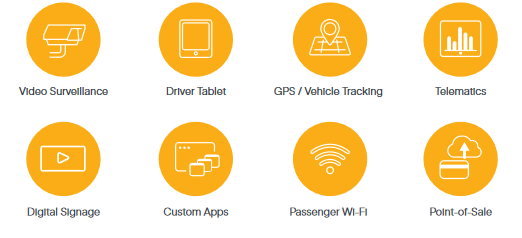IT Buyers’ Guide for Public Transit Network Solutions
Exploring Today’s Connection, Security, and Management Needs for Public Transportation
Connected technologies in public transportation vehicles have become a necessity, not a luxury. Today, on-board devices and applications are essential for providing the operational efficiency and cost savings that mass transit authorities need to stay viable and safe for the people who rely on their services. Further, those same people now expect a variety of features, such as rider Wi-Fi, for the best possible passenger experience. None of these advancements in transit work well without highly reliable wireless connectivity. What’s more, these agencies’ IT teams don’t have the time, money, or staff to manually make every networking connectivity adjustment or data security upgrade one vehicle at a time.
Choosing the right in-vehicle networking solution for an organizations unique needs is critical, with many key factors to consider. This buyers’ guide will provide information about important features and key options so transit authorities can make the best, most informed decision for their communities.
The Digital Transformation of Public Transportation Vehicles
Public transportation’s future is marked by vast potential for vehicle and route efficiency, alternative revenue streams, improved public safety, and fantastic passenger experiences. From metro buses and trains to light rail and ferries, there are many devices and applications that can help solve difficult challenges. GPS and vehicle telemetry data drive real-time decisions that improve service and streamline operations. Video cameras help deter illegal and dangerous behavior. Digital signage enables third-party advertising. Guest Wi-Fi helps passengers get work done or relax on long commutes. These technologies and many more are changing how public transportation is delivered.

What to Look for in a Public Transportation Router Solution
Router Essentials
— Built-in enterprise-grade LTE modem
— Software-defined radio supporting
multiple carriers
— Optional second modem for wireless-
to-wireless failover
—Support for Ethernet and Wi-Fi as WAN
— Dual-band, dual-concurrent Wi-Fi
— Active GPS
Hardware Protection
— Ruggedisation for vibration, shock,
dust, splash, and humidity
— Mounting integrated into the
hardware for optimal placement
and shock resistance
— Automatic router power on and off
to mirror vehicle’s ignition status
— 9-36 DC voltage input range
— Transient and reverse polarity
voltage protection
Software Features
— Centralized and cloud-controlled
configurations, updates and
upgrades, and troubleshooting
— Robust LTE uptime and performance
analytics for actionable insights
— Support for an Intrusion Protection
and Detection System (IDS/IPDS) that
defends against network breaches
— Content filtering
— Expansive cloud-delivered data
security dashboards
Choosing a Networking Solution for Public
Transit Vehicles
Enterprise-grade LTE routers that are purpose-built for vehicles provide secure,reliable connectivity over nationwide mobile networks. And with a cloud-based network management platform in place, IT teams can use dashboards full of rich connectivity and security analytics to centrally make proactive adjustments and perform key troubleshooting duties, instead of having to visit each vehicle every time a change needs to be made. Even the best in-vehicle solutions have key differences to account for prior to a fleetwide purchase and deployment. For example, public transit IT teams need to decide whether they need automatic failover and failback between multiple carriers for increased reliability.
Option 1: Single-Modem Router
In a wireless router with an embedded modem featuring two SIM slots, the radio can only connect to one active SIM card at a time, which is a cost- effective option for organizations that have a minimal budget for mobile data usage. The presence of a second SIM within a software-defined modem enables IT teams to easily and remotely change the WAN connection in any vehicle from one mobile carrier to another.
Integrate All’s Service for Mobile and wireless edge routers include SIM- Based Auto Carrier Selection. This feature detects the carrier of an installed SIM, loads the correct firmware and configuration settings automatically, then connects.
Challenge: Blind Carrier Switching
Technically, wireless failover is possible with single-modem, dual-SIM routers. However, it’s not ideal. When the software detects an outage and switches to the secondary SIM, it can take minutes, not seconds. Further, the system cannot predict whether the second carrier will offer a better connection. If a shift back to the first carrier is necessary, the vehicle could be offline for several minutes.
Option 2: Dual-Modem Router
Using a wireless router with two carriers active within separate modems is the best way to ensure always-on connectivity in public transportation vehicles. This solution is the only option for providing instant wireless-to-wireless failover, or WAN link redundancy. This is an essential service for transit systems, which are constantly traveling in and out of good signal areas for particular mobile carriers.
Integrate All’s SD-WAN features constantly monitor and measure both mobile connections, using intelligent path selection based on mobile signal strength, throughput, latency, and data plan consumption. The most important traffic — such as POS, GPS, and AVL data — can be assigned to the stronger link while less important applications remain connected over the weaker mobile signal.
Contact us and get a consultation for your use case.

